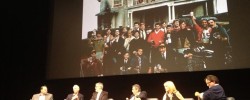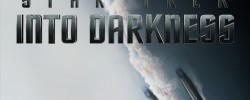
Review: The Painting (2011)

Cast: Jean Barney, Chloé Berthier, Julien Bouanich
Director: Jean-François Laguionie
Country: France
Genre: Animation
Official Trailer: Here
Editor’s Notes: The Painting opened in limited release May 10th. If you’ve already seen the film we’d love to hear your thoughts on it, or if you’re looking forward to seeing it this weekend, please tell us in the comments section below or in our new Next Projection Forums.
“A simple drawing can be more beautiful than an elaborate painting”. It’s rarely a film has the deftness and grace to so succinctly summate its own impact, but that’s precisely the power Jean-François Laguionie’s The Painting possesses as it weaves its story of painted figures in various stages of (in)completion around an emotionally resonant message of self-determination and acceptance. That’s the curious power of expressive animation: abstracting ourselves from our own likeness, we somehow seem to make so much more digestible the difficult existential conceptions of life. It’s just this that Languionie achieves with his tale of three such figures, each from a different social class segregated according to their artistic merit, journeying forth in search of the painter that made them to ask why he has abandoned them.
An extraordinary range of styles and textures populate the film, Languionie evidently calling upon an ocean of influences from Matisse to Modigliani and beyond with a scope to make the most fervent of art aficionados weak at the knees.
 The French title—Le Tableau—would almost be more appropriate for Anglophone audiences, infused with additional meaning as that word is: to call the film The Painting is to somewhat undersell just how magnificent a one it is, just how astonishing the sight of these gorgeously textured figures strewn about these breathtaking landscapes is. Ever before the impact of the film’s layered approach to its difficult themes takes hold, it infests the eyes with its visual style, the vibrant character of its images almost boundless in its lush expressivity. An extraordinary range of styles and textures populate the film, Languionie evidently calling upon an ocean of influences from Matisse to Modigliani and beyond with a scope to make the most fervent of art aficionados weak at the knees. Fluidly transitioning between divergent modes of painterly expression—the occasional fantasy sequence permits the narrative distance required for certain more abstract moments—the film’s digital techniques marry the old and the new beautifully with an elegance that does more to further the case for computer animation than any realistic graphics ever could.
The French title—Le Tableau—would almost be more appropriate for Anglophone audiences, infused with additional meaning as that word is: to call the film The Painting is to somewhat undersell just how magnificent a one it is, just how astonishing the sight of these gorgeously textured figures strewn about these breathtaking landscapes is. Ever before the impact of the film’s layered approach to its difficult themes takes hold, it infests the eyes with its visual style, the vibrant character of its images almost boundless in its lush expressivity. An extraordinary range of styles and textures populate the film, Languionie evidently calling upon an ocean of influences from Matisse to Modigliani and beyond with a scope to make the most fervent of art aficionados weak at the knees. Fluidly transitioning between divergent modes of painterly expression—the occasional fantasy sequence permits the narrative distance required for certain more abstract moments—the film’s digital techniques marry the old and the new beautifully with an elegance that does more to further the case for computer animation than any realistic graphics ever could.
Showcasing the stunning diversity of styles with his cleverly juxtaposing cutting, Laguionie is clearly an enormously talented artist; what’s remarkable, the strengths of his visual abilities considered, is how well he’s able to marry the aesthetic of the film with a beautifully emotive score that’s every bit as affecting as the images he presents us. It’s a sensual wonder, this movie, enticing the eyes and ears both, and through them the heart. For the music and images, for all their astonishing artistry, are but the surface: it’s the emotional resonance the plot imparts that makes Languionie’s a truly great piece of art. There’s a remarkable scene where one of the figures, composed only of light brush strokes and thereby reviled by the society of the painting at large, pulls from his bag the crumpled “body” of his friend, kicked to death in an earlier moment of frightening aggression that attests both the film’s ability to flirt even with horror and its affecting lamentation of our senseless inhumanity. To garner such emotion from characters composed only of simple lines is an extraordinary achievement, but then, isn’t all art—in essence—just lines?
For the music and images, for all their astonishing artistry, are but the surface: it’s the emotional resonance the plot imparts that makes Languionie’s a truly great piece of art.
 To speak of the immense sadness The Painting is capable of achieving is perhaps to do a disservice to the joys it similarly evokes. It is, for all its brooding contemplation, a joyous fairytale at heart, well equipped to lift the spirits with the wonderful whimsy of its adventurous story and the underlying structure of its romantic goals. Perfectly pitched across little over seventy minutes, its enveloping pacing takes us on this engaging tour through art history and human nature both. Languionie has created a film no age group is ill-equipped to enjoy, the knowing simplicity of its overarching metaphor and optimistic twinkle in its eye inviting all who want only to be engaged in a story well-told.
To speak of the immense sadness The Painting is capable of achieving is perhaps to do a disservice to the joys it similarly evokes. It is, for all its brooding contemplation, a joyous fairytale at heart, well equipped to lift the spirits with the wonderful whimsy of its adventurous story and the underlying structure of its romantic goals. Perfectly pitched across little over seventy minutes, its enveloping pacing takes us on this engaging tour through art history and human nature both. Languionie has created a film no age group is ill-equipped to enjoy, the knowing simplicity of its overarching metaphor and optimistic twinkle in its eye inviting all who want only to be engaged in a story well-told.
The slow zoom that follows the opening credits, where the frame of the film moves gradually forward to swallow the frame of the painting is, of course, a pointedly self-reflexive gesture: this is less a paean to the power of painting as it is a testament to the transcendental abilities of all art; Languionie uses this convergence of media to position art—his own art, and indeed all art—as the only feasible answer to the big questions to which the film gestures. We must never be too consumed by our search for the painter to appreciate the diverse beauty of the painting itself. At a time when still, for all our evolution as a species, we seem unable as a society to accept the wonders of the differences between us, perhaps a boundlessly hopeful, lighthearted fable like The Painting is precisely what we need.
Related Posts
![]()
Ronan Doyle
![]()
Latest posts by Ronan Doyle (see all)































